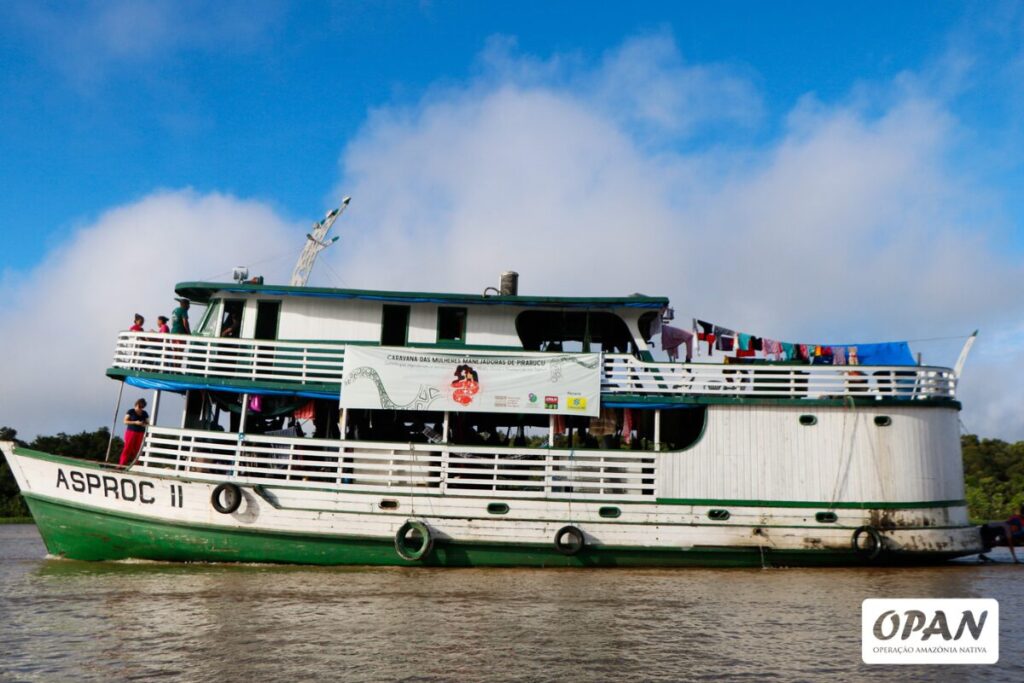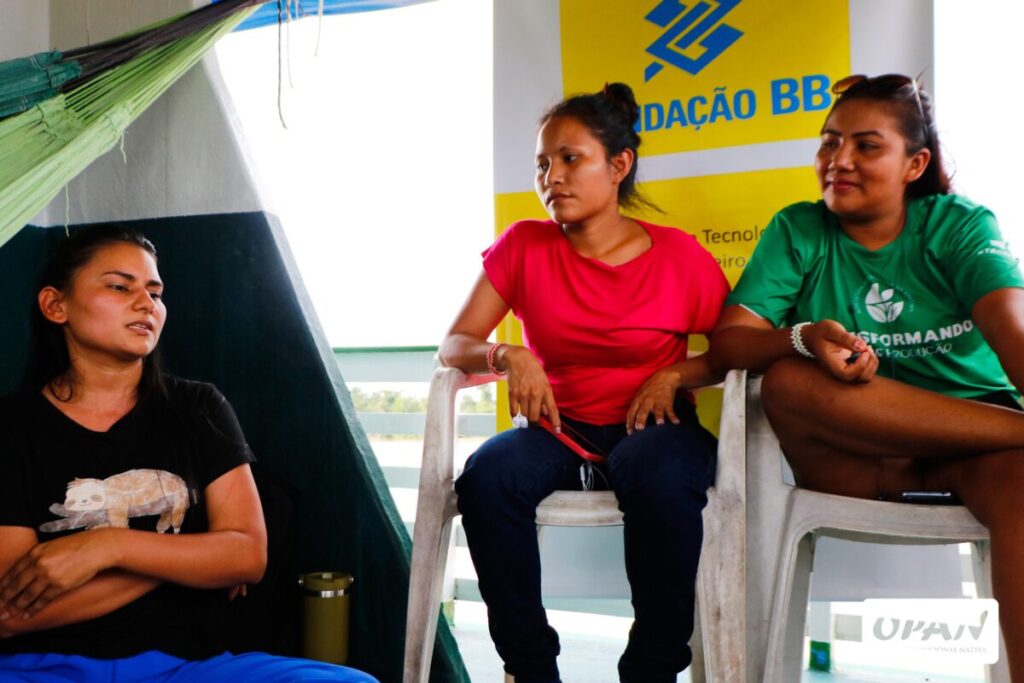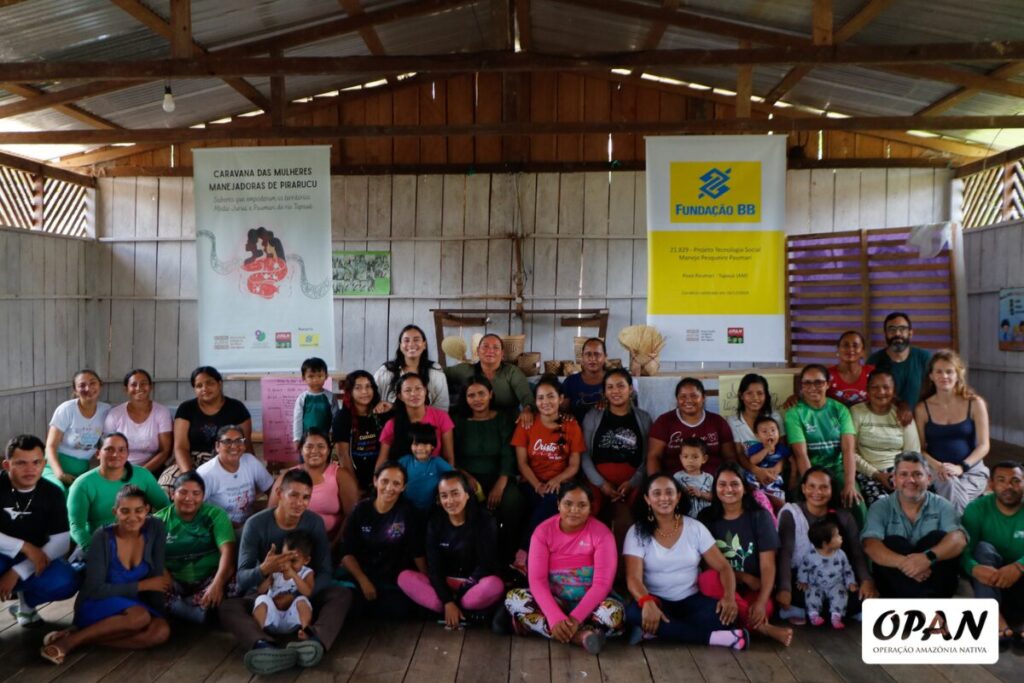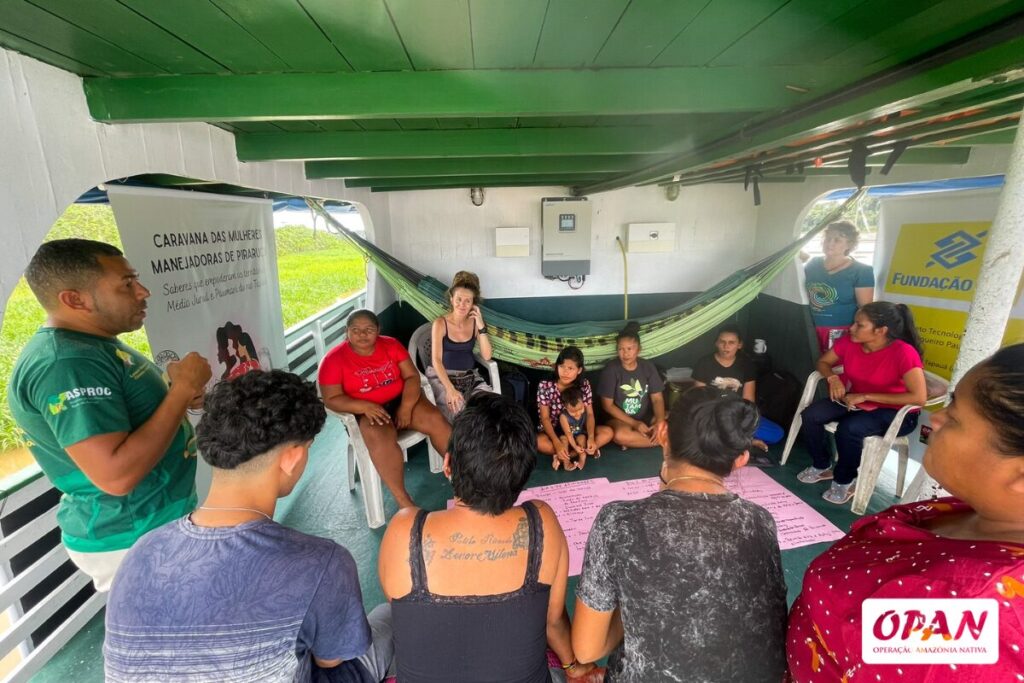Caravan strengthen the role of women in the management of the pirarucu fish
The initiative has joined indigenous peoples and the extractive industries in the exchange of experiences along the Juruá river
By Talita Oliveira | OPAN
“At the end of the village, was a bit of a challenge, this is the first time that I’m traveling to is so far away from my territory,” said Gabriele, Paumari, manejadora in the Village of Manissuã, in the municipality of Tapauá. A member of the Associação Indígena do Povo das Águas (AIPA), it was one of the group of nine women in the Paumari, which saw a three-day boat ride from Manaus, and the other, a 41-hour boat ride to Carauari at the southwest corner of the House.
This whole journey was for a special purpose; to be part of a “Caravan of Women, Manejadoras de Pirarucu”, an event that ran through the communities along the river Early, and promoting encounters between indigenous women and the extractive industries, which act on the sustainable management of the pirarucu. “I’m very happy to be here with my partner. We’re going to share our experience with you, and I think that that’s going to strengthen our work,” said Gabrielle.

Sponsored by the AIPA and the Associação das Mulheres Agroextrativistas do Médio Juruá (ASMAMJ), with the support of the Operação Amazônia Nativa (OPAN), the initiative is part of the Award, the Bank of Brazil Foundation of Technology and the Social order. By 2024, the management of fisheries is developed for the people in the Paumari, was one of the experiences of the winners of the 12th edition of the awards, which cemented a partnership with the Foundation of the Bank of Brazil, and securing resources to strengthen and expand the business.
Knowledge that will empower the territories of the Middle Early, and the Paumari of the Tapauá river
In addition to the Paumari of the Tapauá river, took part in the women of the Extractive Reserves (Resex) in the Low-and Middle-Early and is from the area of the Settlement of the Fisheries of the Carauari, covering the counties of Early, and Carauari. The representatives of the various institutions that support the management, also attended the meeting.

The exchange of knowledge among women of different cultures and backgrounds from the territories — the Land of the Indigenous, Resex, and the area of the Fish made up the event, to enrich your dialogue, and you, through the various forms of the social organization of the women’s manejadoras in their communities. “To strengthen our foundations, our communities, and the territory, is one of the main goals of the field trip. Once our land is empowered society, and all over the world, you can be empowered, especially us women,” he reflected, Rosângela Cunha, the president of the ASMAMJ.
São Raimundo Community
After 24 hours of travel, the caravan, and arrived in the Community of St. Thomas, in the Resex Médio Juruá, where it took place for the first date. When Do Canuto, board member of the community, has opened up a dialogue, emphasizing the power and importance of women in management.
“I think that’s all we want to do we have the capacity to do, and the management has come to show it to all of us. In today’s day and women that are not in management, and there is no management,” he said. The claim Also is a literal one: in the community, they account for 49% of the people that are involved in the activity.

In the early history of the participation of women in the management of the community, how to combine motherhood with work, the collective strategies of the organization, as well as a demonstration of the various techniques, the evisceration of the pirarucu, are just a few of the topics discussed at the meeting. The women were also able to get to know the community, and a visit to the impressive initiative of a Solar power Plant, the structure of the solar panels were acquired by the community, with the resources generated by management, which replaced the generators and fuel, and provide clean electric power for all the family.
The schedule also included is a dialog between the members of the “Youth in the struggle For a Walk (JLPC), a group that works to mobilize the youth, for the defence, and the sustainability of their communities. “I thought that was very important to the work of environmental education, led by the young people, this is something that I want to take you to my village,” said Cleide the Paumari, manejadora of the Village and the Colony.
Lago Serrado Community
After about 16 hours to get down to the river Early on, the ship’s convoy attacked in the community of Lake of Bushland situated in the area of the Settlement of the Fishery of the Lower Carauari. The machine is driven by Fernanda Moraes, chair of the Residents ‘ Association Agroextrativistas of the Low-and Medium-Early (AMAB), and it was held with the participation of the students in the School of Manuel de Souza Moraes — a symbol of the collective struggle waged by the community for the sake of education.
“At the beginning of the whole story, from the management, don’t imagine for a moment such as this one, for women, going out in the caravan, and by joining forces with each other by sharing their experiences with you. To many people today it is quite an achievement. Everyone is fighting for something that is our right,” said Nina.

In the dialogue, and the women reported that the activity of the management of the arapaima has made it possible to gain direct access to the financial resources and decision-making on fisheries issues before they dealt with almost exclusively by men. “With the money I got from the management that I was able to make my dream come true of having a phone, the rural, and thus be able to communicate with others,” the story, I Ivaneide Lima, manejadora of the community, Botafogo, and board member of the Association of Rural Workers in the Early (ASTRUJ).
Conversations in motion
While the trade-off between the communities and the dialogue continued on to the board, bringing together representatives of local associations and support organizations that support the management and to the social organization of the Middle Early. In addition to the AIPA, ASMAMJ and OPAN, also took part in key institutions such as the Association of Rural landowners of the Carauari (Asproc), and the Institute-a Non – e of the Fund, the Distribution of the Benefits of the Medium-Early, that is presented in the context of the history of the decades-long mobilization, which is in the region of a reference in a leading role in the community.

“In the Medium-Early, if it makes it to the fortress that is today, because it has all of these people fighting for communities, not only in the Asproc, there is a set of associations fighting for the improvement of the lives of the people,” said Jose da Silva Gomes, a contributor to the Asproc, and the coordinator of the management of the lakes, in the Middle Early.
Other connections
The trip to the Women’s Manejadoras they get involved in a more comprehensive strengthening of women’s participation in the sustainable management of the pirarucu, a topic which is increasingly used in the case of associations and organizations that are working on the situation.
In 2023, the group of the Arapaima has created the working group on Gender, Youth, and at-grade Intersections to bring attention to diversity in management, with an initial focus on women. The first meeting of the working group came in 2024, with the participation of indigenous women Paumari.
The interactions between the women who work in the management of the pirarucu fish, and they play multiple roles in the social, they have expanded their understanding of the ways of the community-based organization. From the exchange of knowledge between the different areas and situations, are instruments of collective reflection, and collaborative efforts that add value to the participation of women in all phases of the operation. “We’ve learned that the achievements of the communities that are the result of the union of the people. We came back strong to take in new knowledge, and the strength of the union, and to our people,” he said with Ana Paula, Paumari, the secretary of the AIPA.
The trip will also connect to the proceedings of the organization of women in the Paumari around the artwork. Also, in 2024, a team he participated in the city of Manaus in the event of Gamu kabadani Hida, it is the job of the women in the Paumari, carried out by the AIPA, which led to an exchange with the other initiatives of women, indigenous and non-indigenous people who are craft-in the capital city of the state of amazonas.
